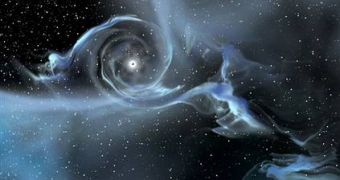The black hole that now holds the record of the biggest stellar black hole ever discovered, is situated in a nearby dwarf galaxy called IC 10 at a distance of 1.8 million light-years away from Earth. The previous record was held for only two weeks by a stellar black hole that had a mass of 16 times that of the Sun, and was located in the galaxy M33.
The currently discovered heaviest "small" black hole defies the current theories of black hole formation from massive stars, with a mass of approximately 24 to 33 times that of the Sun.
A stellar black hole forms when a star that has depleted its fuel starts losing balance between the gravitational pull and the nuclear reaction taking place in its core. As the balance between the two forces becomes larger, the star suffers an implosion. A large part of the gases that form it explode outwards, but during this process extreme pressure is exerted on its core, forcing it to compress and collapse on itself under its own weight.
As a result of the star's explosion, the remnant core can be transformed into a white dwarf of a black hole, depending on the size of the previous star. A dying star of 3 or more times the mass of the Sun is most likely to produce a black hole, as a result of its death.
Stellar black holes are generally known to have a mass 10 times that of the Sun.
Black holes are illusive objects that might hide many of the secrets of the universe. They have infinite gravitational pull on their surface, and the mass is concentrated in a so-called singularity, of zero volume which has only two dimensions, current physical theories postulate that two dimensional objects cannot exist in our universe. The extreme gravitational pull on their surface makes it impossible for matter ever to escape from it.
Black holes trap all matter and light entering their event horizon. As large as they are, stellar black holes are considered small compared to the super massive black hole, situated at the center of the galaxies.
The scientist were able to calculate the mass of the black hole, as a rare alignment with its companion star took place. They observed that the black hole was periodically being eclipsed by a star orbiting it. The periodical changes in the X-ray brightness enabled them to calculate the mass of both objects.
The black hole is thought to be at least 24 solar masses, and any future optical observations of IC 10 is likely to increase the black hole's mass. The star from which the black hole formed is thought to have had an original mass 60 times that of the Sun.

 14 DAY TRIAL //
14 DAY TRIAL //